Economy & Markets
1 minute read
When will the crisis in U.S. housing affordability end—and how?

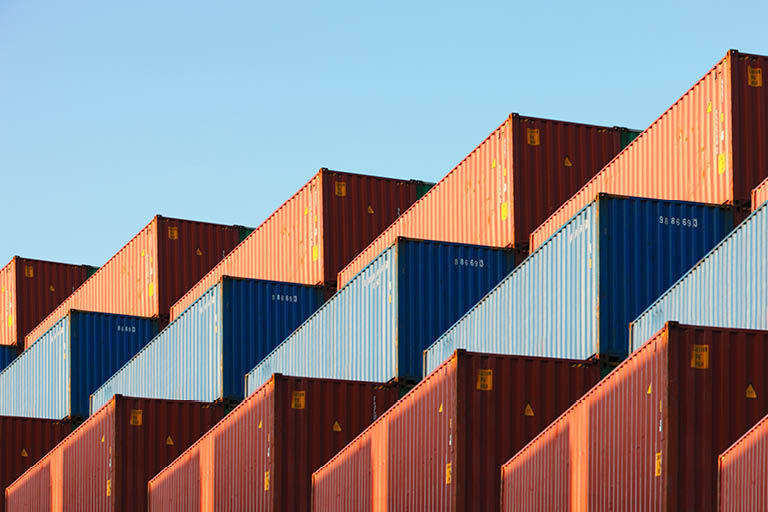
Since the U.S.-China trade war began in 2018, and with increasing intensity during COVID, investors have expressed concerns about deglobalization. That’s the idea that the world is becoming less interconnected through trade, which has the potential to hurt financial markets, GDP growth and corporate profits.
The good news first: As of late 2023, the world’s economies were not rapidly deglobalizing. Economic integration, and its benefits to corporate profit margins, remain intact. That’s despite two serious hits: the tariffs the United States put on many Chinese imports, and the unprecedented sanctions placed on Russia for invading Ukraine that produced an even more extreme trade shock.
Our analysis of the trade data shows supply chains proving flexible and resilient, and production shifting elsewhere. Supply chains are mostly diversifying—what might be called a slow-moving maturation away from excessive concentration in China. This is positive for economic growth in a variety of countries, and bodes well for resiliency of the global trading system against future economic shocks.
Now the less-good news: For several critical imports—most crucially pharmaceuticals (life sciences and biotech) and advanced weapons components—the United States still relies heavily on China, raising significant bipartisan concern as a national security risk.
President Joe Biden in late November invoked the Defense Production Act (used in the Second World War to convert factories to military use) to stimulate reshoring of critical production—returning to the United States corporate operations previously moved to another country—spurred in part by a U.S. pharmaceuticals shortage.
Here, we examine the emerging patterns in international trade, the countries that are benefiting, the outlook for critical goods, and what the reshoring impulse could mean for investors as it unfolds further in the coming years.
Since China was at the center of the trade tensions beginning in 2018, one would expect to see China’s share of global trade declining if the world were de-globalizing. Yet China’s share of global exports is up. Also up: the ratio of global trade in goods to global industrial production.1

Yet country-specific divergences are at work underneath the surface. China asserted its dominance in exports beginning in the 2000s, when it gained 10 percentage points (ppt) in U.S. import share after it was admitted to the World Trade Organization. China’s share of U.S. imports then dropped materially during the ongoing U.S.-China trade war that began in 2018.
Once the U.S. imposed tariffs on about 66% of imports from China as part of the trade war, the locality of trade shifted markedly. While China’s share of U.S. imports declined from 2016 to 2023, those declines were offset by gains made by member nations of the Association of Southeast Asian Nations (ASEAN), and by India and countries in Latin America. (The nations of Central and Eastern Europe, the Middle East and Africa [CEEMEA] did not see U.S. trade share gains in this period.)
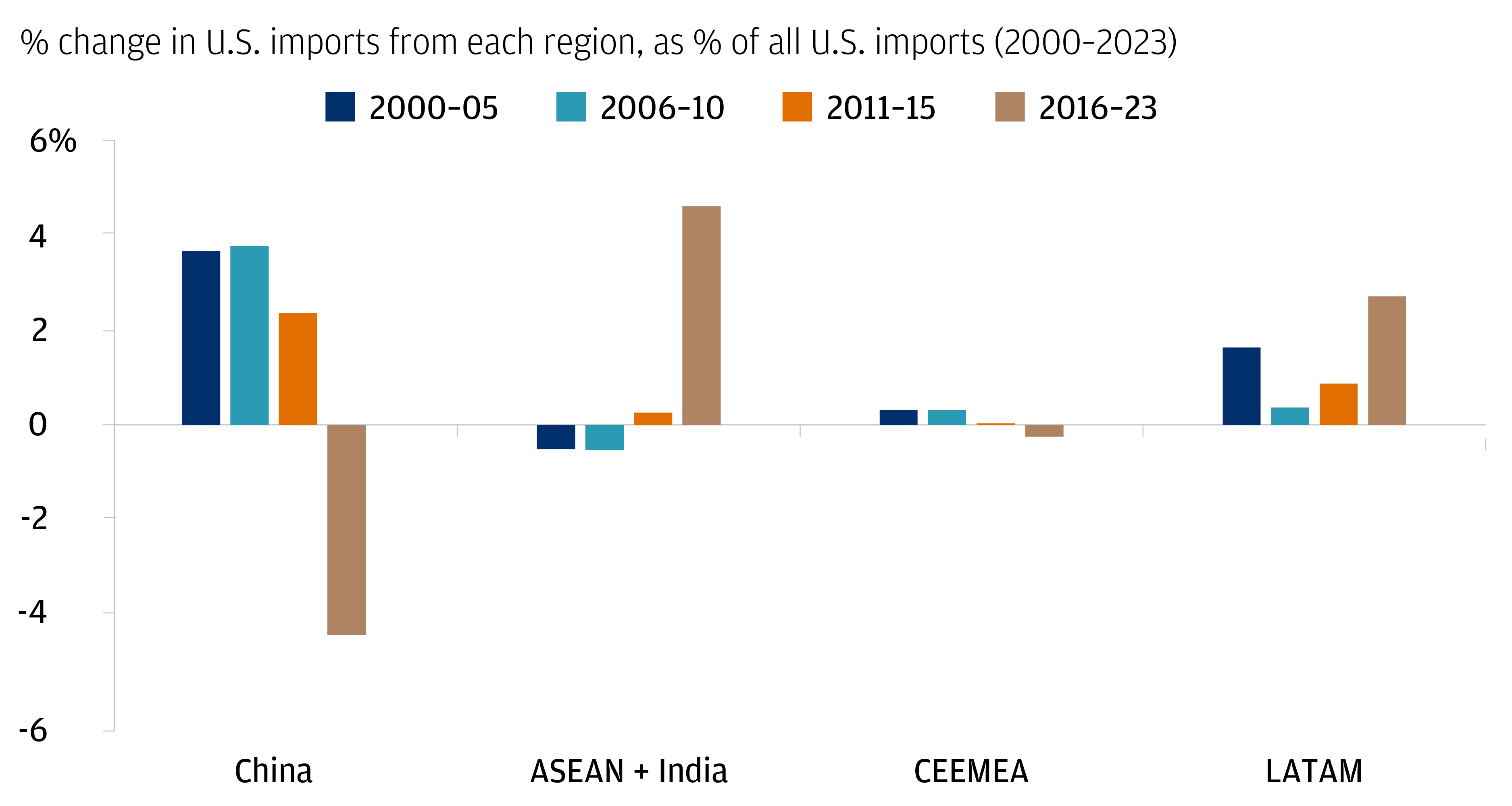
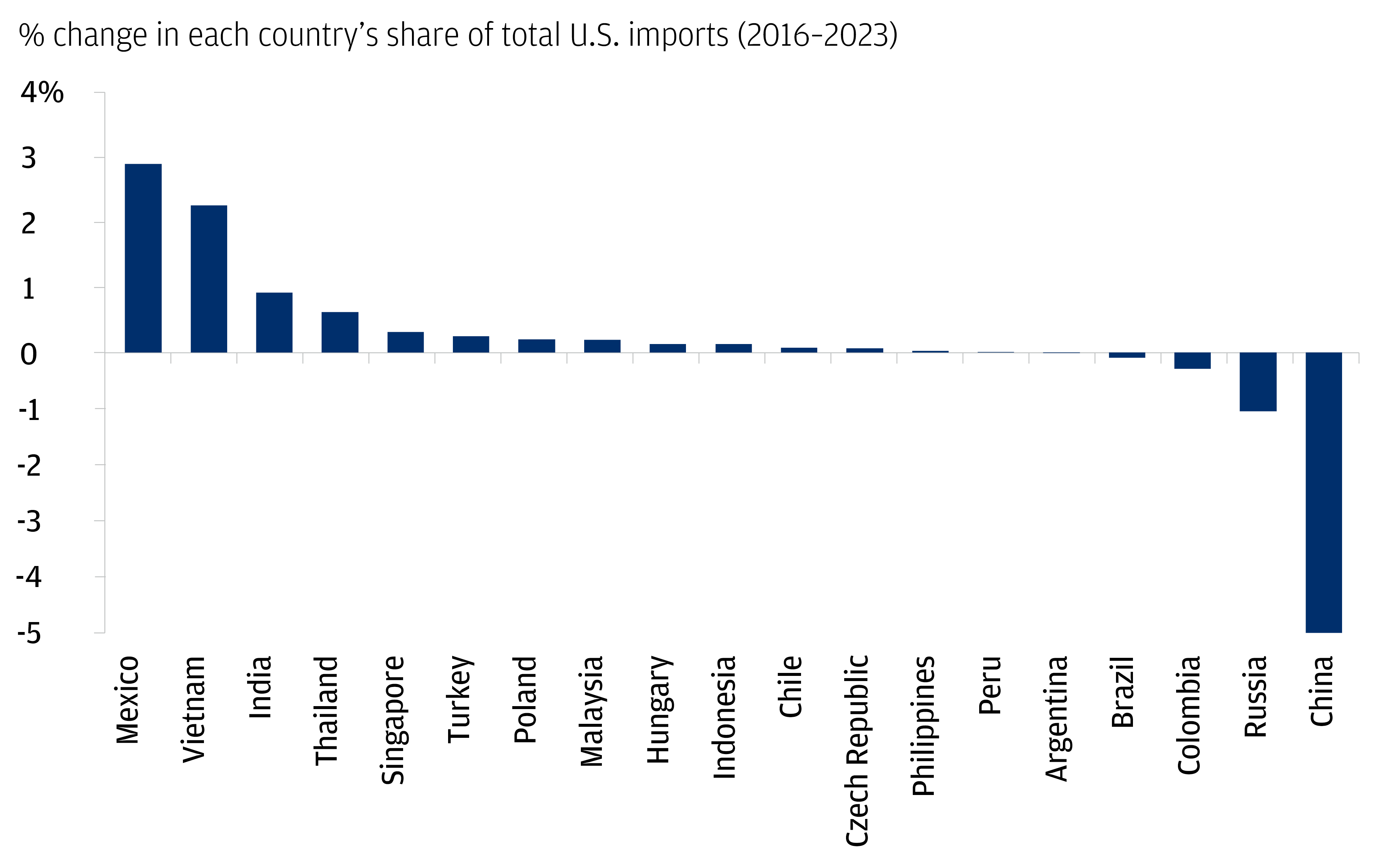
U.S. imports of tariffed items from China fell by about $70 billion. As that occurred, our analysis shows, Vietnam saw the largest percentage gain in exports of tariffed items: a rise of 170%. But Mexico has seen the largest gains in USD terms, at more than $153 billion. The most significant of those exports: semiconductors and related electronic components; auto parts; and other items that were hit by 25% tariff rates imposed on China, such as oils obtained from bituminous minerals.
The Appendix includes a table listing the items tariffed in the U.S.-China trade war, and how the value of U.S. imports of them changed from 2016 to 2023 for the five countries that saw the largest change in share (China, Mexico, Vietnam, India and Thailand).
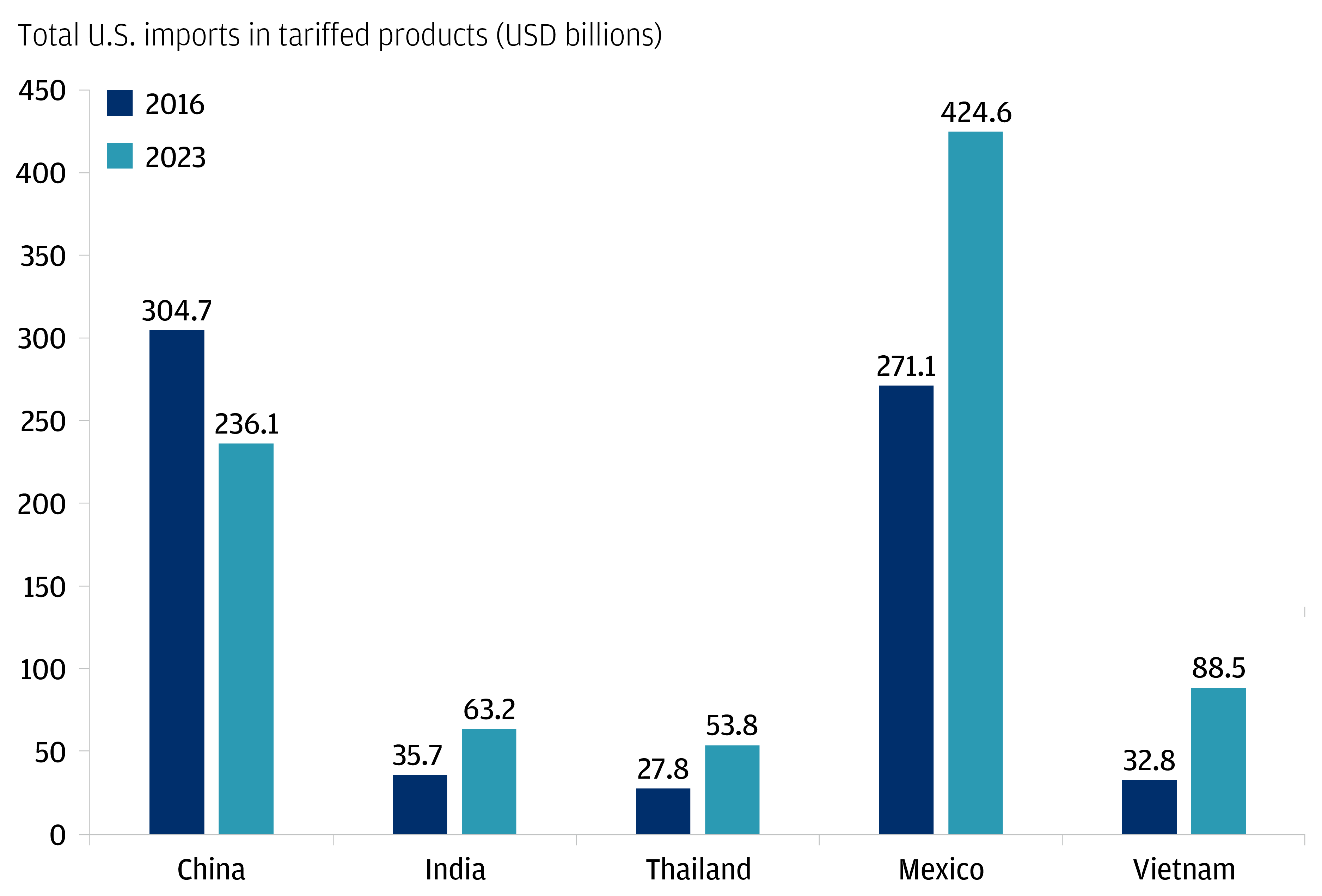
Some migration of trade away from China likely would have occurred even without the trade war. China has been climbing the value chain, offshoring lower value-added production to less expensive locations. For example, China’s value-add in machinery and equipment exports rose markedly in the period we’re discussing, while its value-add in apparel exports shrank.2 Increasingly, it hasn’t made sense to keep less complex and labor-intensive production in China as its labor costs have risen.
This becomes relevant in considering U.S. dependency on sophisticated Chinese exports today, including biotech and advanced weapons components. The more China establishes a moat around sophisticated exports through its various endowments, incentives and the character of its economy,3 the harder it will be for the United States to de-risk from China in critical areas related to national security.
Transshipping, value-add and import substitution
More generally, we can’t say precisely to what degree the trade war, the move offshore of low-end manufacturing from China, or the war in Ukraine accounted for other countries’ export gains to the United States. But we have derived insights by segmenting trade data at a granular level.4
Furthermore, our analysis supports the notion that trade rerouting (the transshipping of goods through a third country) has been more pronounced for Vietnam than Mexico. Value-added domestic production has likely driven Mexico’s export gains more materially.5 This feature of Mexico’s U.S. export gains supports the notion that greater resiliency is being built into the U.S. import base, helped by Mexico’s proximity and linkage to the U.S. rail system.
Viewed from a corporate perspective, companies are increasingly looking to strengthen their supply chains via reshoring (or “near”-shoring) of production, according to extensive International Monetary Fund (IMF) research on the topic. Mentions of the words reshoring, onshoring and near-shoring in corporate earnings presentations rose “almost ten-fold” since the U.S.-China trade war began.6
It is important to note, as well, that Mexican legislators have pushed for more value-added production. The 2018 U.S.-Mexico-Canada Agreement’s (USMCA’s) “rules of origin” require North American inputs into production, especially in the autos sector.7
Reshoring activity in Mexico, however, is unlikely to be a boon for jobs: The share of employment in manufacturing in Mexico has in fact fallen in recent years,8 likely because of industrial automation. This may reflect a larger shift more generally: As industrial automation gathers steam globally, the global trading system may be moving to a state in which companies do not seek to optimize primarily for the lowest labor costs, but for other cost factors, such as shipping costs.9 Mexico stands out in this regard, with its substantially lower shipping costs to the United States than China.
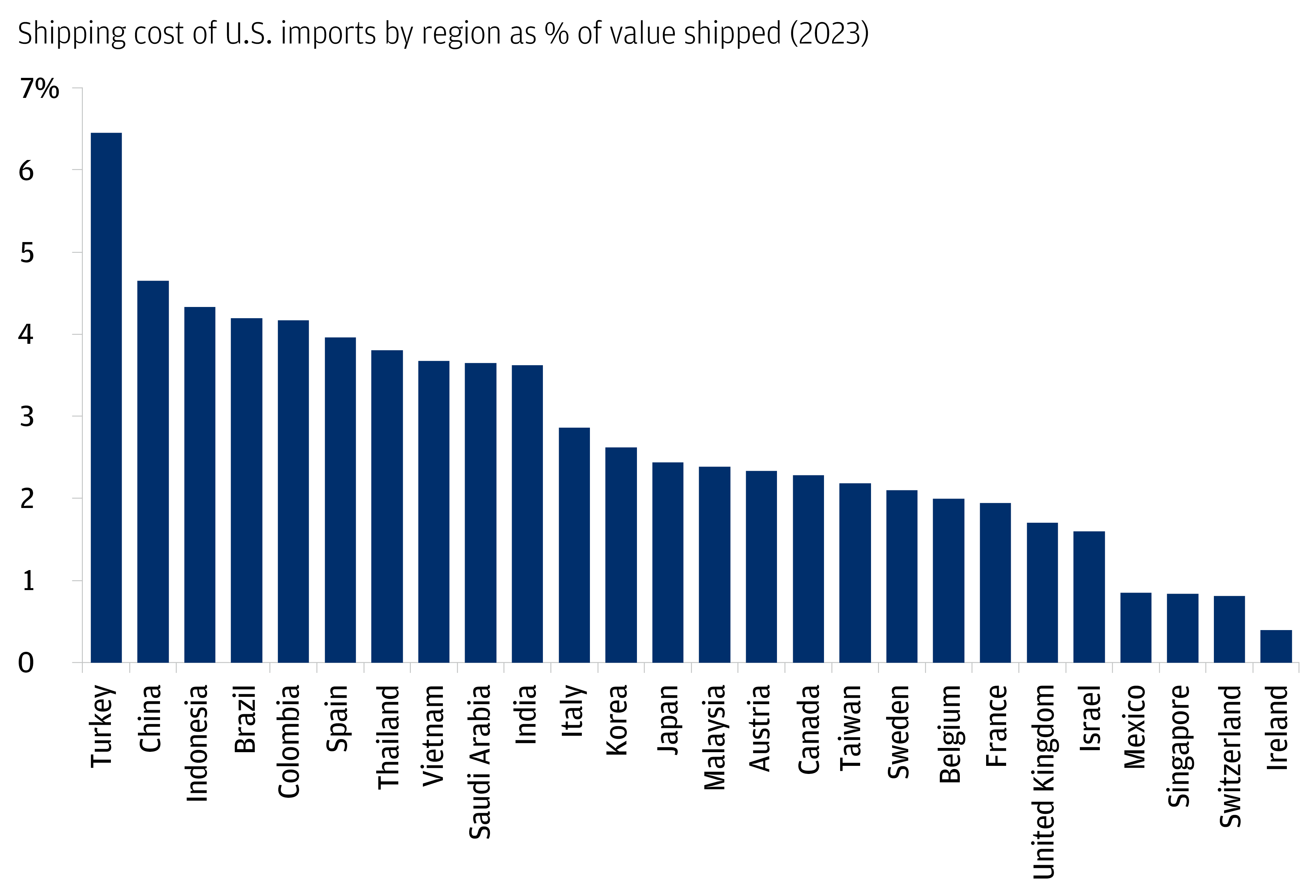
A sharp decline in China’s semiconductor (and equipment) exports to the United States have also been wrapped into the U.S.-China trade war: These have declined by about 54% from 2016. China’s semiconductor exports could not be easily substituted by other chipmakers, particularly because China specializes in “legacy” (less sophisticated) chips with low profit margins.
This lack of substitution likely played an important role in the inflation shock that hit the U.S. economy in 202110—the severe shortage of chips for automobiles and other discretionary items is where the 2021 inflation shock began.11
This indicates the vulnerability of the global trading system and why such a high reliance on China for critical imports—the topic we turn to next—can represent not only a national security risk, but an economic risk as well. It also illustrates why, in the long run, the reshoring of supply chains can build greater resiliency into the trading system, helping guard against future shocks.
The reliance on China for several crucial products, including life sciences, biotech and advanced weapons components, is a target of bipartisan concern as a serious risk to U.S. national security.
How have U.S. imports changed for these strategic goods, defined as advanced technology products (ATPs) by the U.S. Census Bureau? ATPs comprise 10 broad categories (updated annually): biotechnology, life science, opto-electronics, information and communications, electronics, flexible manufacturing, advanced materials, aerospace, weapons and nuclear technology.12 Surprisingly, ATPs have been less impacted by U.S. tariffs than other categories of goods.
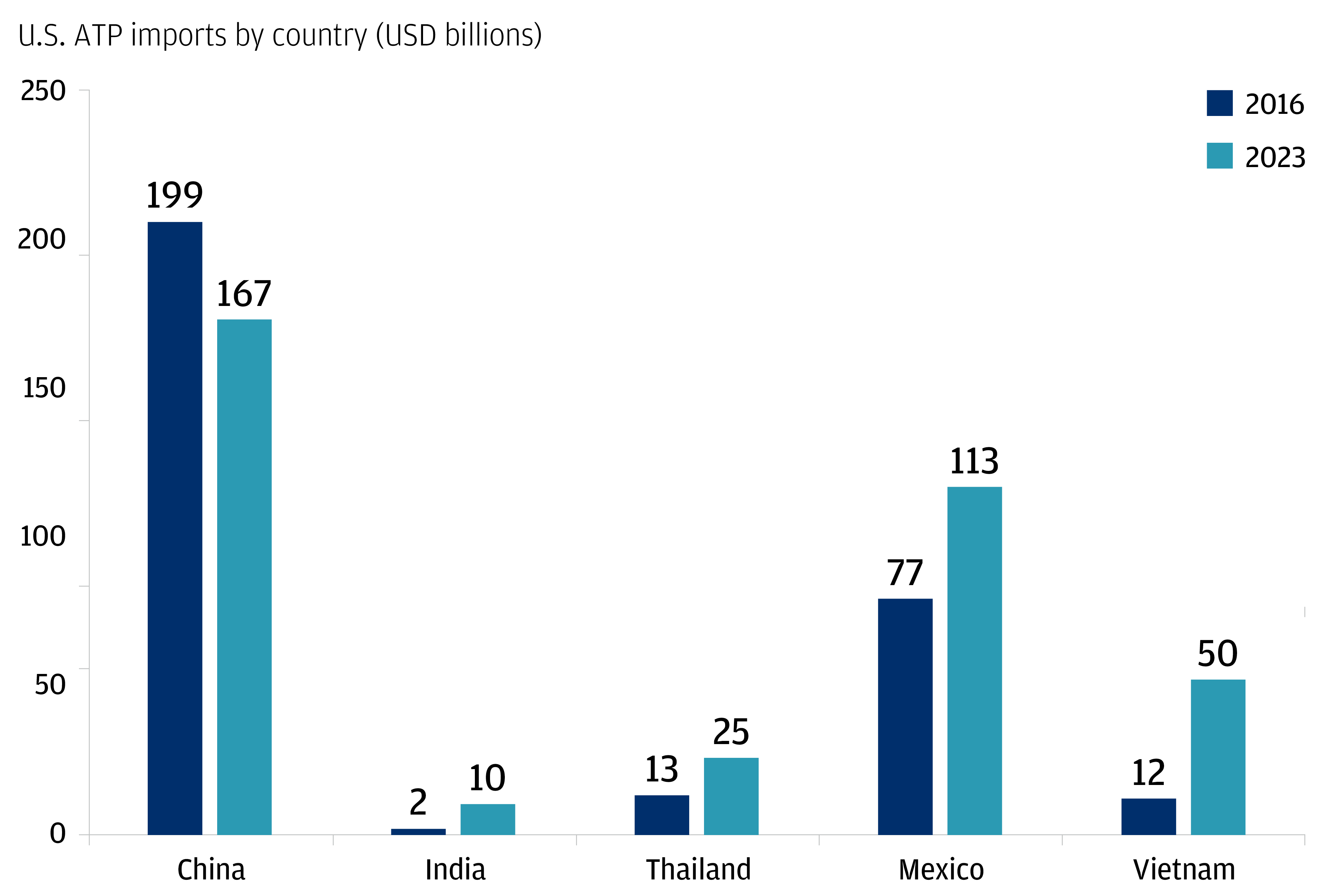
A fraction of ATPs were heavily tariffed in the trade war. These products were, for the most part, electronics, flexible manufacturing, advanced materials, aerospace and nuclear technology. But they were not the majority of the ATPs the United States imports from China: Only about 45% of U.S. imports of ATPs from China were hit with tariffs in the trade war.
Indeed, several strategic ATPs—biotechnology, life science and weapons—were less subjected to tariffs, and China’s share of these exports to the United States are not declining, but rising today. Within ATPs, it is noteworthy that where the United States did not add tariffs (non-tariffed ATP exports), China is still making gains: These exports are up about $20 billion from 2016. (See the appendix for the ATP category breakouts behind this rise).
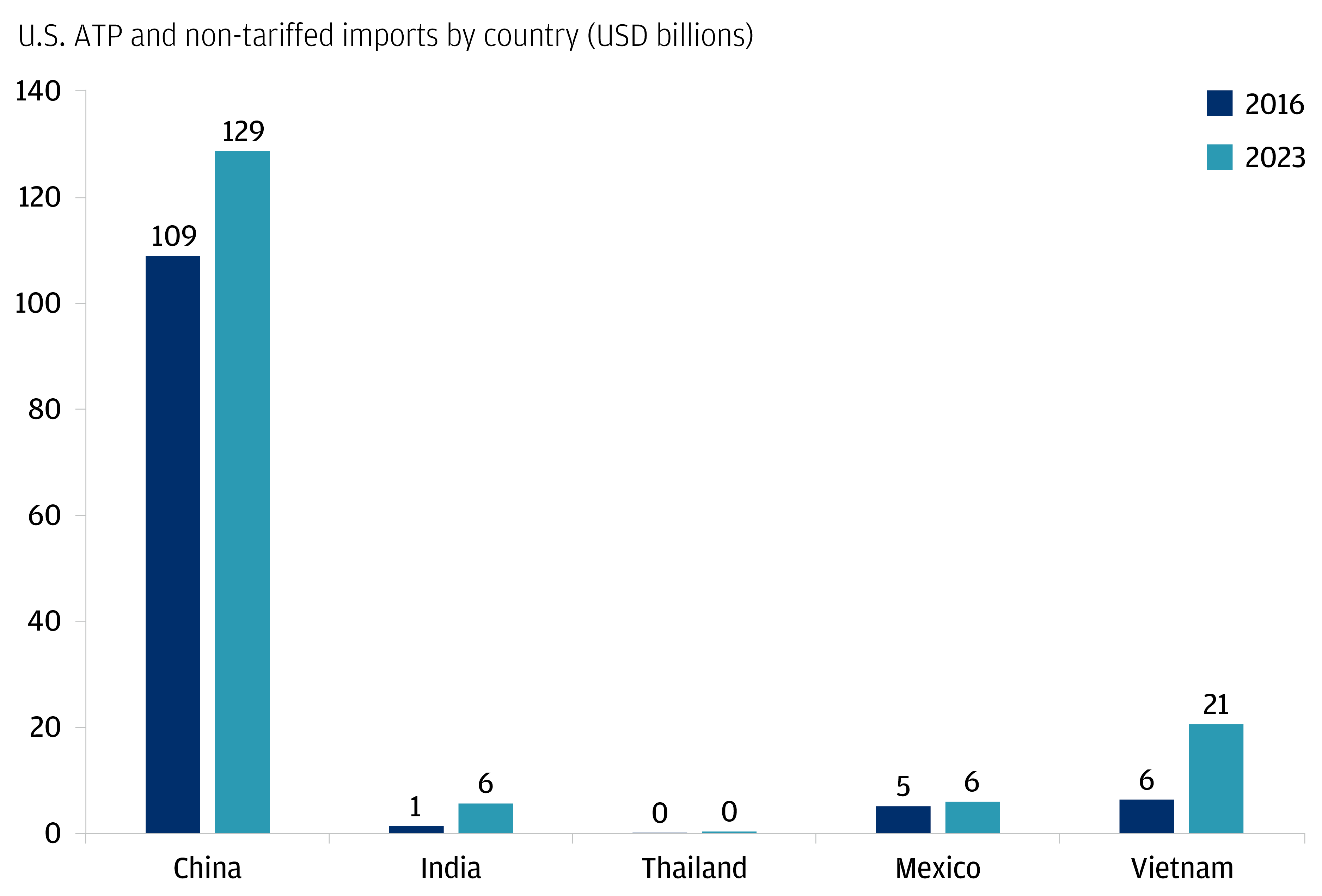
U.S. imports of life-saving pharmaceutical drugs from China have been rising substantially in recent years. To many U.S. lawmakers, this presents a national security risk. Yet the country has had little choice but to rely ever more on China for pharmaceuticals, given the severe shortages of production capacity at home.13
The Biden Administration is aware of this critical choke point, and in November 2023 invoked the Defense Production Act to enable faster investment in domestic manufacturing of essential medicines, medical countermeasures and the critical inputs that the President has deemed essential to U.S. national defense.14
Contrary to the pattern of countries other than China gaining export share in products subject to tariffs, in non-tariffed ATP exports to the United States, their rise has been less impressive.
It will be important to continue watching the evolution of non-tariffed ATP exports, as gains in this category in the coming quarters and years could indicate manufacturing supply chain shifts in anticipation of a further heightening of U.S.-China trade tensions.15 We will monitor these decisions by multinational business leaders, who remain highly uncertain about policymakers’ intentions around strategically important non-tariffed ATP exports.
As mentioned, tariffs have played an important role in shifting the locality of trade away from China. Yet when it comes to those strategically important technological products from China not tariffed, China’s exports to the United States remain robust. Relative to China’s GDP, such non-tariffed ATP exports to the United States are not just stable, but now exceed 2018’s level, even as overall U.S. imports from China have plummeted.16
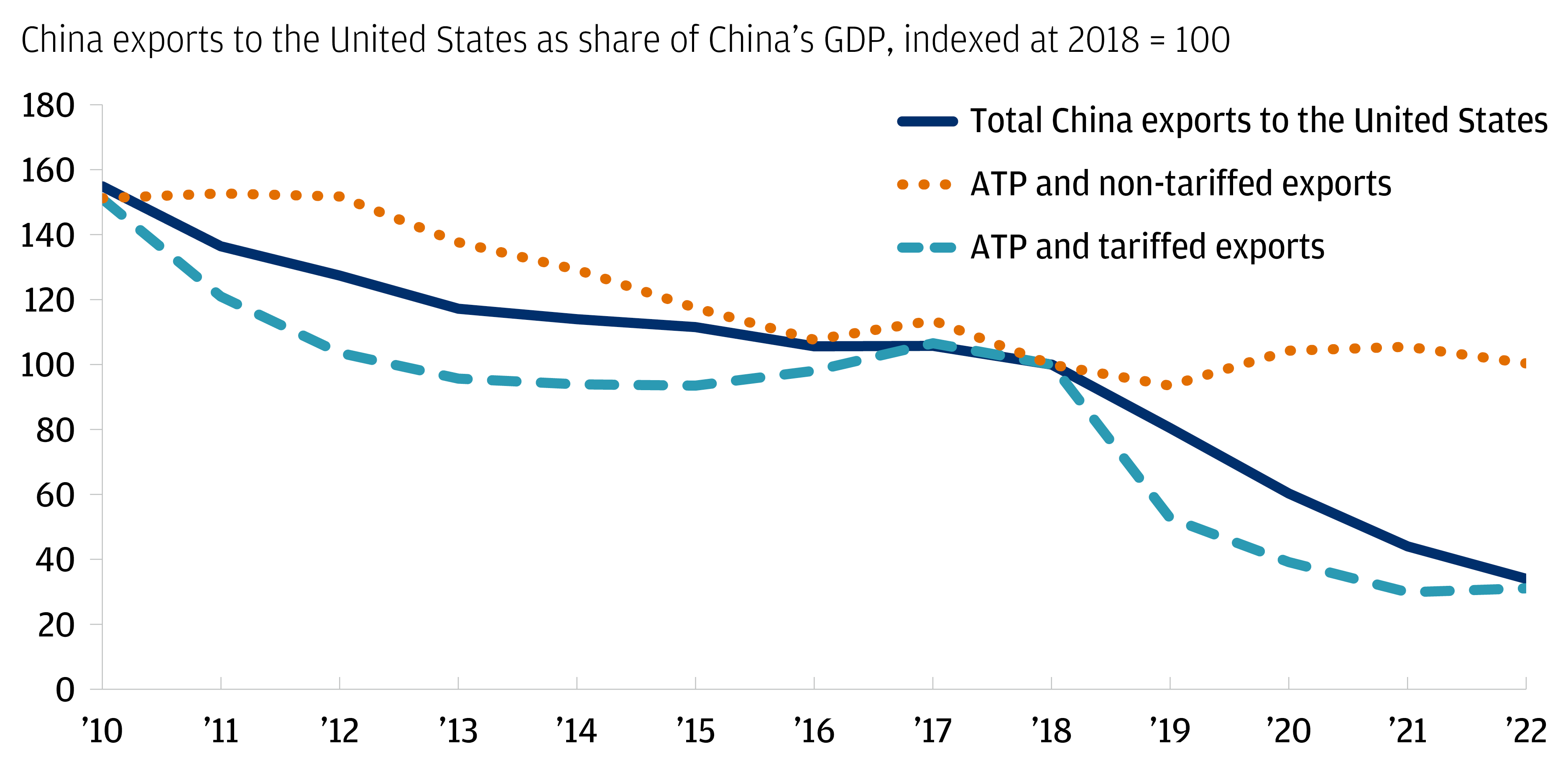
Where might strategic trade go from here?
The U.S.-China trade war has had large effects in terms of diminishing China’s exports to the United States. However, the more we dig into the details of the drop in trade, the more we see a nuanced picture—one where the United States is still heavily reliant on China for certain strategically important categories of trade.
We expect U.S. lawmakers will look to further de-risk by disengaging from China in trade in these critical sectors. The exact form that de-risking effort will take will depend, to a high degree, on the outcome of the 2024 U.S. presidential elections.
The Democratic Party is likely to continue a push for policies aimed at lowering production costs in the United States and for its proximal trading partners (such as Mexico), while putting fiscal dollars toward increasing the demand for reshoring in targeted sectors (examples to date include the CHIPS Act of 2022 and the Inflation Reduction Act of 2023).17 The Republican Party appears primarily focused on raising the costs of foreign-produced products (e.g., through the use of tariffs).18
Two final case studies serve to contrast the state of globalization today: Russia is a dramatic example of trade flexibility, illustrating how resilient supply chains can preserve a nation’s imports despite unprecedented global sanctions. On the other hand, South America’s lack of rising U.S. export share shows how key factors (including infrastructure and human development) can stymie trade, despite the potential offered by a flexible global trading system.
Russia: A dramatic example of trade flexibility
Trade with Russia since the outbreak of the war in Ukraine presents a dramatic recent example of trade flexibility. Global manufacturing supply chains have demonstrated such resilience over the last 18 months that they essentially have saved Russia’s economy. Trade flexibility is the primary reason the IMF has dramatically revised up its forecast for Russian GDP since April 2022. Then, the IMF projected a 10.6% drop by 2023 (relative to the 2021 level). Now the IMF sees the Russian economy larger by 0.13%.
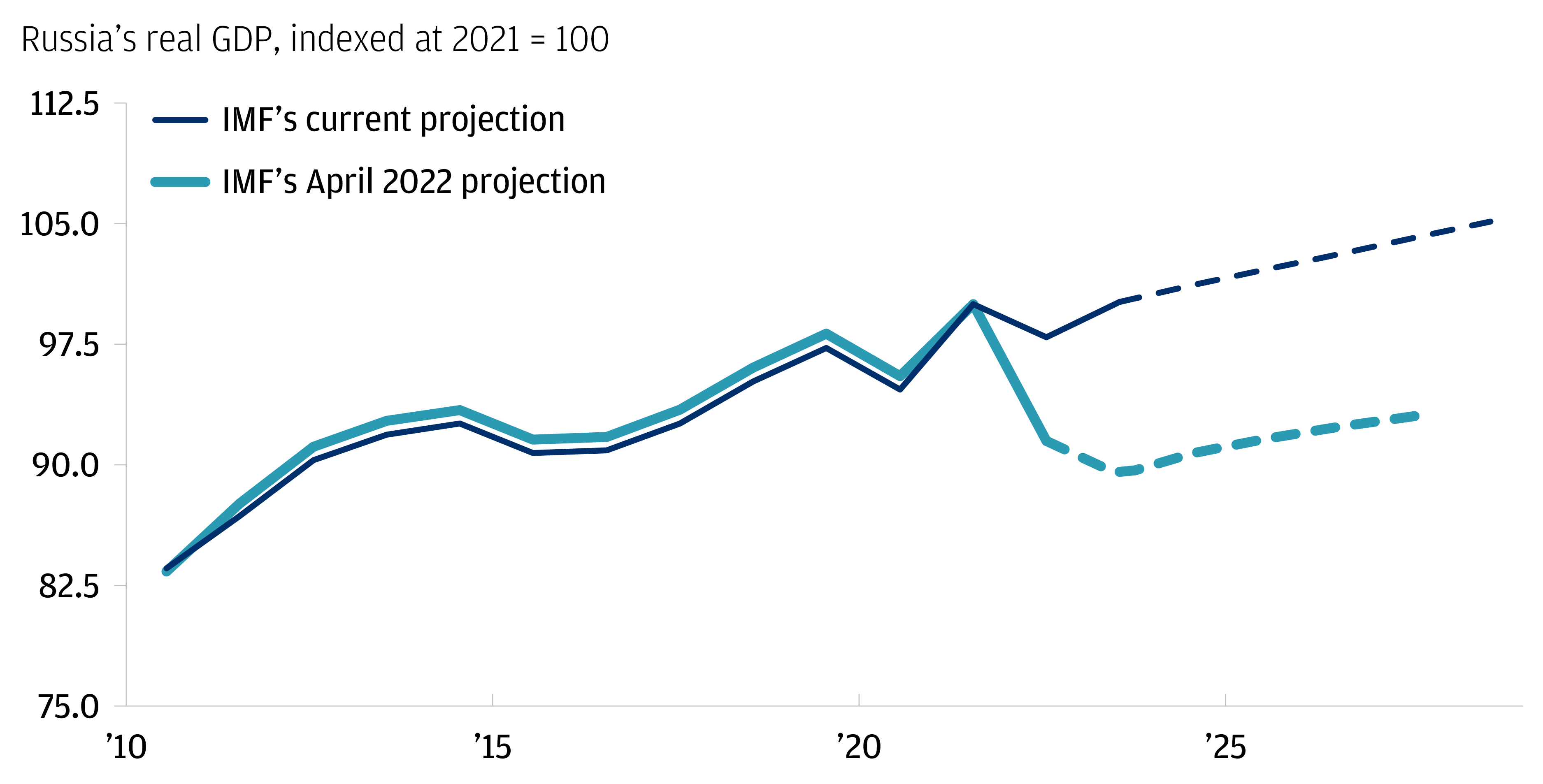

South America: So much potential, so little gain
We expected trade diversification would have produced strong U.S. export share gains for countries in South America. These countries have a favorable proximity to, and historically close geopolitical ties with, the United States. Instead, the export shift has been almost nonexistent for Brazil, Colombia, Argentina, Chile and Peru.
Several reasons may explain the region’s lagging performance.
Low manufacturing complexity: Of total U.S. imports of advanced technology products in 2023, the percentage originating in South America rounds to nearly zero (0.31%). The largest economies’ top exports are primary commodities: iron ore in Brazil, copper ore in Peru and Chile, and crude petroleum (and coffee) in Colombia.

Poor quality and limited trade infrastructure: South American countries’ exports would be 30% higher in a hypothetical world in which their infrastructure gaps versus advanced economies were closed by half.19 Shipping costs to the United States are high (unlike Mexico, the continent lacks a direct link to the U.S. rail system). The planned, ambitious Bi-Oceanic Railway project to connect Peru’s Pacific Coast with Brazil’s Atlantic shore would reduce shipping costs, particularly to Europe and Asia, but it has met repeated setbacks (including environmental: It would traverse the Amazon rainforest).20
Comparatively low human capital development (the stock of knowledge, skills, education, health and other attributes that contribute to workers’ ability to produce economic value): Combined with relatively low English proficiency,21 the region’s lagging human capital development is limiting goods trade and likely holding back services exports too, even as its time zone is well suited for selling remote work services to North American companies.22
Globalization remains intact, despite several large shocks in recent years. Its preservation is a testament to the flexibility of manufacturing supply chains globally. Multinational corporations have shown they can quickly adapt to new policies and pivot around heightened geopolitical risks. This flexibility has helped corporate profit margins maintain the historic gains that were made in recent decades due to globalization.
Yet in several areas of key strategic importance, the United States still relies heavily on imports from China. We expect leaders to continue pushing for policies aimed at de-risking from China in these areas of trade that are critical for national security. This emerging challenge presents an opportunity for a variety of countries in the emerging markets complex. Trade infrastructure, competitiveness and human capital development will largely dictate which ones benefit from these trends.
Additionally, our work supports a positive view on the Industrials sector in the equity markets globally. Michael Cembalest, Chairman of Market and Investment Strategy for J.P. Morgan Asset & Wealth Management, recently wrote favorably about the Industrials sector in his 2024 Outlook, citing durable secular growth drivers and inexpensive valuations (especially relative to technology stocks).
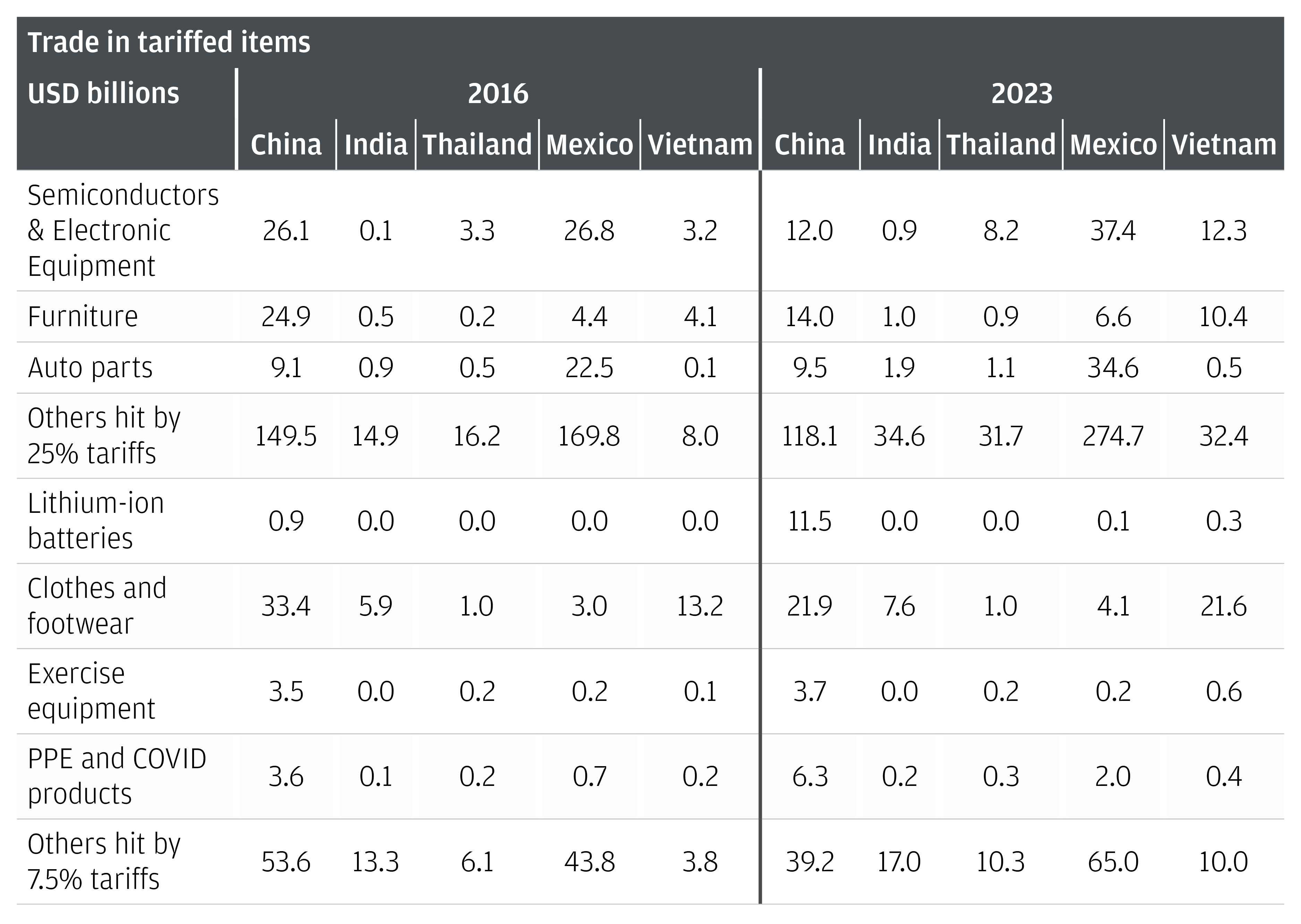
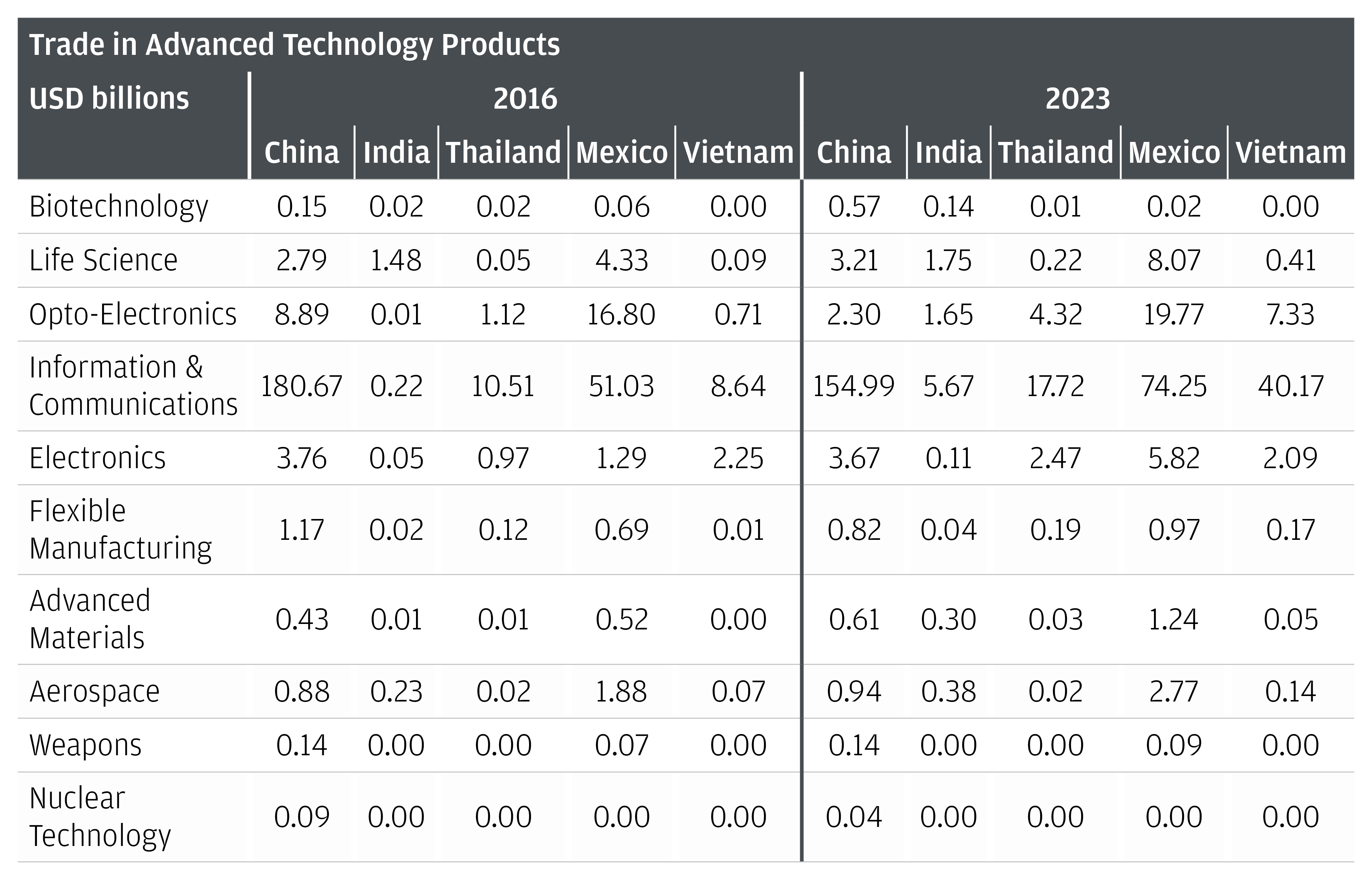

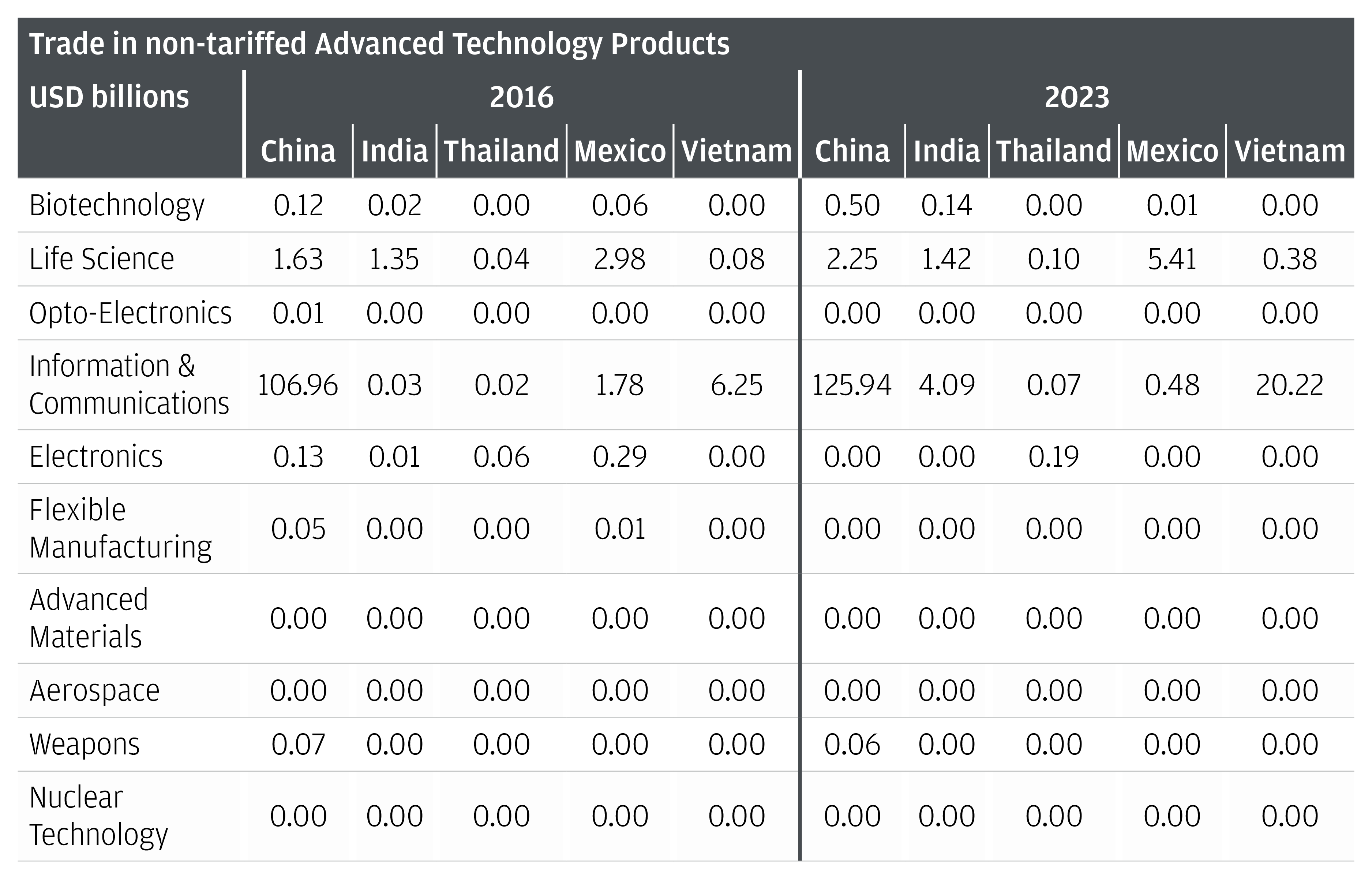
1Although outside the scope of this article, we also note that the rise of remote work around the world has boosted the global trade in services, a trend likely to continue unfolding. Tobias Sytsma, “The Globalization of Remote Work: Will Digital Offshoring Make Waves in the U.S. Labor Market?” RAND Corporation, 2022.
2According to the OECD’s Trade In Value Added (TIVA) database, the value-added share in China’s apparel exports fell from 17.2% in 2000 to 9.4% in 2020, while the value-added share in China’s machinery exports more than doubled over this period from 2.5% to 5.5%. “TIVA principal indicators,” oecd.org, 2023.
3While beyond the scope of this article, this “moat” may be said to include mineral deposits, quality of education and manufacturing sector integration, among many other factors in China’s historical rise in manufacturing dominance. For recent dominance in production of technologies: Alan Weissberger, “ASPI’s Critical Technology Tracker finds China ahead in 37 of 44 technologies evaluated,” Technology Blog, IEEE Communications Society, Institute of Electrical and Electronics Engineers, March 3, 2023.
4We use novel constructions of the data, utilizing the Harmonized Tariff Schedule (HTS) coding system to examine the components of U.S. goods imports. We consider HTS trade categories at the most granular level, HTS 10-digit codes.
5Significant lags in data publication prevent us from answering this question definitively today. Yet by examining the trend in tariffed exports (relative to GDP) before and after 2018 (start of trade war), we see a sharp rise in tariffed goods exported from Vietnam to the United States, and do not see that for Mexico. This supports the notion that trade re-routing has been more pronounced in Vietnam, reflective of goods being exported from China to Vietnam then re-exported to the United States to sidestep tariffs.
6Kristalina Georgieva, “Confronting Fragmentation Where It Matters Most: Trade, Debt, and Climate Action,” IMF Blog, January 16, 2023.
7USMCA raised the regional value content requirement to 75%, from NAFTA’s 62.5%, and required at least 70% of producers’ steel and aluminum purchases originate in North America. To be sure, Chinese manufacturers are also building out export infrastructure in Mexico to get closer to the U.S. consumer market and, according to The Economist, to sidestep tariffs. “Why Chinese companies are flocking to Mexico: The country offers a back door to the United States,” The Economist, November 23, 2023.
8From 8.9% in 2019 to 8.25% in 2023, according to the Instituto Nacional de Estadística y Geografía.
9We would also note that labor costs are not demonstrably lower in Mexico than in China. The (adjusted) Big Mac Index, produced by The Economist and commonly used as a proxy to compare labor costs, shows that Mexico is 17.1% less expensive than the United States, while China is 15.6% less expensive.
10Chad P. Bown, “Four years into the trade war, are the U.S. and China decoupling?” Realtime Economics blog, Peterson Institute for International Economics, October 20, 2022.
11In our view, April 2021 marked the beginning of the inflation shock. During this month, automobile inflation in the CPI data soared by more than a 60% annualized rate.
12International trade reference codes, the U.S. Census Bureau.
13Eduardo Jaramillo, “U.S. drug shortages highlight dependence on China, gray supply chains,” The China Project, June 7, 2023.
14“Fact Sheet: President Biden Announces New Actions to Strengthen America’s Supply Chains, Lower Costs for Families, and Secure Key Sectors,” White House, November 27, 2023.
15Justin R. Pierce and David Yu, “Assessing the Extent of Trade Fragmentation,” FEDS Notes, Board of Governors of the Federal Reserve System, November 3, 2023.
16We also note a discrepancy between the U.S. import from China data versus the China export to the U.S. data. This discrepancy emerged during the pandemic and has remained since. The United States is now reporting far fewer imports from China than what China is reporting as exports to the United States. It’s not obvious what to make of this discrepancy, but it could mean the drop in overall imports from China to the United States is being overstated.
17For our analysis of these laws and their likely impact and investment implications, see Joe Seydl, Jessica Matthews and Ian Schaeffer, “The opportunity in renewed U.S. industrial policy,” J.P. Morgan Private Bank, June 1, 2023.
18We would note that the CHIPS Act of 2022 was a bipartisan piece of legislation, so this statement shouldn’t be interpreted as black or white. We make it nevertheless because it fits with the election-cycle pattern, and because former U.S. President Donald Trump has stated that if he wins re-election in 2024, he plans to slap a 10% tariff on all U.S. imports.
19Trade infrastructure refers to both physical infrastructure and customs infrastructure. “Trade Integration and Implications of Global Fragmentation for Latin America and the Caribbean,” Regional Economic Outlook Latin America and the Caribbean, International Monetary Fund, October 2023.
20“Controversial Amazon route of Transcontinental Railway Brazil-Peru,” Global Atlas of Environmental Justice,” ejatlas.org, June 11, 2023.
21Especially in relation to GDP per capita (a proxy for the inexpensiveness of labor from the perspective of corporations looking for outsourced remote work), the countries in South America stand out as having low English proficiency scores (relative to, for example, India and the Philippines). English Proficiency Index, Education First, 2023.
22The lion’s share of rising remote work exports to North America (and Europe) has been captured by workers based in Eastern Europe, Southern Asia and the Philippines. Fabian Braesemann, Fabian Stephany, Ole Teutloff, et al., “The global polarization of remote work,” PLoS One, October 20, 2022.
We can help you navigate a complex financial landscape. Reach out today to learn how.
Contact usLEARN MORE About Our Firm and Investment Professionals Through FINRA Brokercheck
To learn more about J.P. Morgan’s investment business, including our accounts, products and services, as well as our relationship with you, please review our J.P. Morgan Securities LLC Form CRS and Guide to Investment Services and Brokerage Products.
JPMorgan Chase Bank, N.A. and its affiliates (collectively "JPMCB") offer investment products, which may include bank-managed accounts and custody, as part of its trust and fiduciary services. Other investment products and services, such as brokerage and advisory accounts, are offered through J.P. Morgan Securities LLC ("JPMS"), a member of FINRA and SIPC. Insurance products are made available through Chase Insurance Agency, Inc. (CIA), a licensed insurance agency, doing business as Chase Insurance Agency Services, Inc. in Florida. JPMCB, JPMS and CIA are affiliated companies under the common control of JPMorgan Chase & Co. Products not available in all states.
Please read the Legal Disclaimer for key important J.P. Morgan Private Bank information in conjunction with these pages.
INVESTMENT AND INSURANCE PRODUCTS ARE: • NOT FDIC INSURED • NOT INSURED BY ANY FEDERAL GOVERNMENT AGENCY • NOT A DEPOSIT OR OTHER OBLIGATION OF, OR GUARANTEED BY, JPMORGAN CHASE BANK, N.A. OR ANY OF ITS AFFILIATES • SUBJECT TO INVESTMENT RISKS, INCLUDING POSSIBLE LOSS OF THE PRINCIPAL AMOUNT INVESTED
Bank deposit products, such as checking, savings and bank lending and related services are offered by JPMorgan Chase Bank, N.A. Member FDIC.
Not a commitment to lend. All extensions of credit are subject to credit approval.